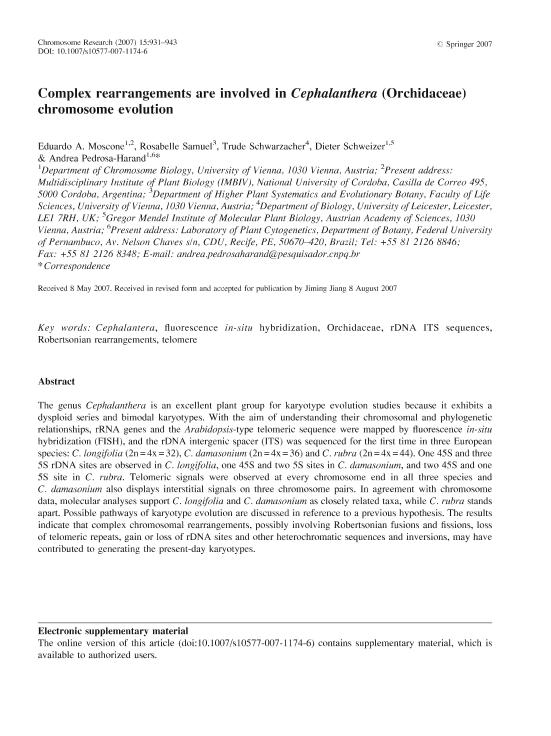Mostrar el registro sencillo del ítem
dc.contributor.author
Moscone, Eduardo Alberto

dc.contributor.author
Samuel, Rosabelle
dc.contributor.author
Schwarzacher, Trude
dc.contributor.author
Schweizer, Dieter
dc.contributor.author
Pedrosa-Harand, Andrea
dc.date.available
2017-12-14T15:32:11Z
dc.date.issued
2007-12
dc.identifier.citation
Moscone, Eduardo Alberto; Samuel, Rosabelle; Schwarzacher, Trude; Schweizer, Dieter; Pedrosa-Harand, Andrea; Complex rearrangements are involved in Cephalanthera (Orchidaceae) chromosome evolution; Springer Netherlands; Chromosome Research; 15; 7; 12-2007; 931-943
dc.identifier.issn
0967-3849
dc.identifier.uri
http://hdl.handle.net/11336/30597
dc.description.abstract
The genus Cephalanthera is an excellent plant group for karyotype evolution studies because it exhibits a dysploid series and bimodal karyotypes. With the aim of understanding their chromosomal and phylogenetic relationships, rRNA genes and the Arabidopsis-type telomeric sequence were mapped by fluorescence in-situ hybridization (FISH), and the rDNA intergenic spacer (ITS) was sequenced for the first time in three European species: C. longifolia (2n = 4x = 32), C. damasonium (2n = 4x = 36) and C. rubra (2n = 4x = 44). One 45S and three 5S rDNA sites are observed in C. longifolia, one 45S and two 5S sites in C. damasonium, and two 45S and one 5S site in C. rubra. Telomeric signals were observed at every chromosome end in all three species and C. damasonium also displays interstitial signals on three chromosome pairs. In agreement with chromosome data, molecular analyses support C. longifolia and C. damasonium as closely related taxa, while C. rubra stands apart. Possible pathways of karyotype evolution are discussed in reference to a previous hypothesis. The results indicate that complex chromosomal rearrangements, possibly involving Robertsonian fusions and fissions, loss of telomeric repeats, gain or loss of rDNA sites and other heterochromatic sequences and inversions, may have contributed to generating the present-day karyotypes.
dc.format
application/pdf
dc.language.iso
eng
dc.publisher
Springer Netherlands
dc.rights
info:eu-repo/semantics/openAccess
dc.rights.uri
https://creativecommons.org/licenses/by-nc-sa/2.5/ar/
dc.subject
Cephalantera
dc.subject
Orchidaceae
dc.subject
Fluorescence in Situ Hybridization
dc.subject.classification
Otras Ciencias Biológicas

dc.subject.classification
Ciencias Biológicas

dc.subject.classification
CIENCIAS NATURALES Y EXACTAS

dc.title
Complex rearrangements are involved in Cephalanthera (Orchidaceae) chromosome evolution
dc.type
info:eu-repo/semantics/article
dc.type
info:ar-repo/semantics/artículo
dc.type
info:eu-repo/semantics/publishedVersion
dc.date.updated
2017-11-03T20:46:08Z
dc.identifier.eissn
1573-6849
dc.journal.volume
15
dc.journal.number
7
dc.journal.pagination
931-943
dc.journal.pais
Países Bajos

dc.journal.ciudad
Dordrecht
dc.description.fil
Fil: Moscone, Eduardo Alberto. Universidad de Viena; Austria. Consejo Nacional de Investigaciones Científicas y Técnicas. Centro Científico Tecnológico Conicet - Córdoba. Instituto Multidisciplinario de Biología Vegetal. Universidad Nacional de Córdoba. Facultad de Ciencias Exactas Físicas y Naturales. Instituto Multidisciplinario de Biología Vegetal; Argentina
dc.description.fil
Fil: Samuel, Rosabelle. Universidad de Viena; Austria
dc.description.fil
Fil: Schwarzacher, Trude. University of Leicester; Reino Unido
dc.description.fil
Fil: Schweizer, Dieter. Universidad de Viena; Austria
dc.description.fil
Fil: Pedrosa-Harand, Andrea. Universidad de Viena; Austria
dc.journal.title
Chromosome Research

dc.relation.alternativeid
info:eu-repo/semantics/altIdentifier/url/https://link.springer.com/article/10.1007/s10577-007-1174-6#citeas
dc.relation.alternativeid
info:eu-repo/semantics/altIdentifier/doi/https://doi.org/10.1007/s10577-007-1174-6
Archivos asociados
